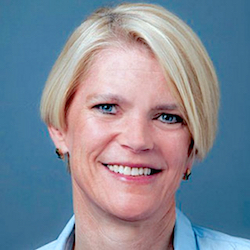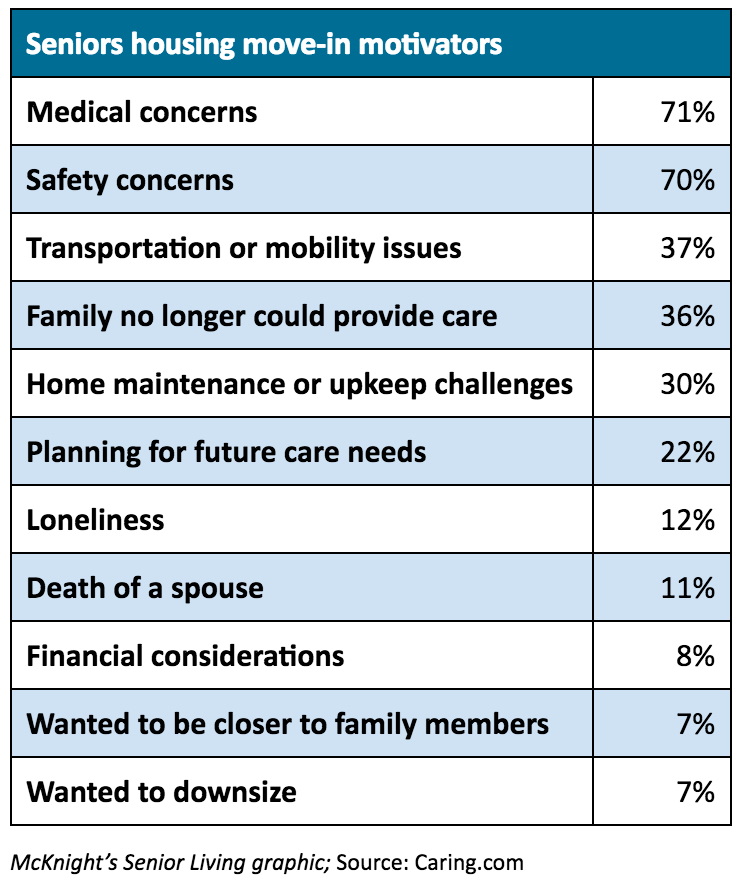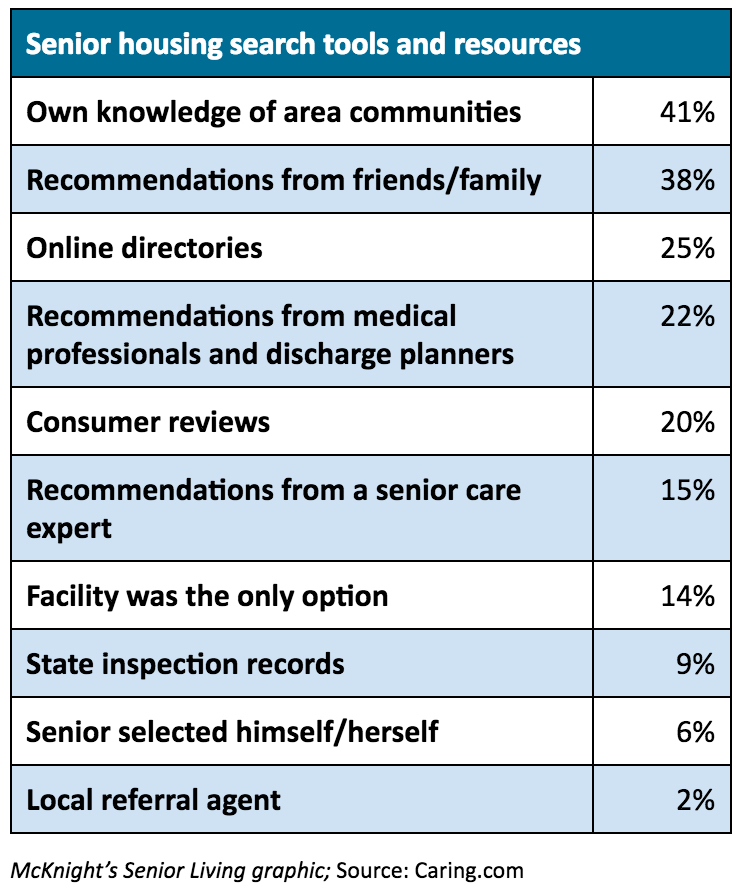
Medical and safety concerns are the chief motivators for moves into senior living communities, according to the results of the latest Caregiver Journey survey by Caring.com.
The San Mateo, CA-based website, a Bankrate company that serves as a resource for family caregivers, in July and August polled 2,512 consumers who had visited its website and partner senior care-related websites. Twenty-two percent of participants said that a loved one lives in an assisted living community, nursing home or other type of senior living setting.
Of them, 71% said that medical concerns were the reason for the move, and 70% said that safety concerns were the reason. (Survey participants could choose more than one answer.)
 “These numbers are actually going up. Last year, medical concerns was about 62%,” Caring.com Vice President of Advertiser Sales and Marketing Katie Roper told those attending a Thursday webinar where she discussed the survey results. “So despite all of the efforts in the industry to sell the value of socialization and community living, it’s still medical and safety drivers that are the key factors in these decisions, and it’s getting to be more frequent rather than less frequent.”
“These numbers are actually going up. Last year, medical concerns was about 62%,” Caring.com Vice President of Advertiser Sales and Marketing Katie Roper told those attending a Thursday webinar where she discussed the survey results. “So despite all of the efforts in the industry to sell the value of socialization and community living, it’s still medical and safety drivers that are the key factors in these decisions, and it’s getting to be more frequent rather than less frequent.”
See the accompanying table for additional reasons survey respondents gave for move-ins.
Senior housing search tools and resources
Given the nature of the survey, all participants said they used online tools to research communities. Forty-one percent said they leveraged their own knowledge of area communities in their searches.
 “I have people all the time who say, ‘I don’t need to market online because everybody in my community already knows me,’ ” Roper said. “What this [survey] says is, almost 60% of people don’t know any communities in the area, or at least not ones they would feel comfortable with using in their search for senior care.”
“I have people all the time who say, ‘I don’t need to market online because everybody in my community already knows me,’ ” Roper said. “What this [survey] says is, almost 60% of people don’t know any communities in the area, or at least not ones they would feel comfortable with using in their search for senior care.”
Another popular source for research, she said, was recommendations from family members and friends, with 40% of respondents citing them. See the accompanying chart for additional tools and resources that family caregivers used in the search process for senior living communities.
Factors in community selection
When Caring.com asked caregivers an open-ended question (rather than a multiple choice question) about why they chose a particular community for their loved one, a community’s location was “the overwhelming driving factor in terms of which one was selected,” Roper said. Twenty-two percent of respondents mentioned location as their top consideration, and one-third mentioned it somewhere in their answers.
 Only 10% of respondents mentioned that a community’s physical facility was a reason for choosing a particular community, Roper said. “I hate to tell you, but the chandelier in the lobby? Nobody really cared about it,” she added. Respondents who cited a community’s physical facility were more likely to mention a particular apartment’s layout or the fact that it had a lot of natural light or a garden than they were to mention a well-appointed lobby, Roper said.
Only 10% of respondents mentioned that a community’s physical facility was a reason for choosing a particular community, Roper said. “I hate to tell you, but the chandelier in the lobby? Nobody really cared about it,” she added. Respondents who cited a community’s physical facility were more likely to mention a particular apartment’s layout or the fact that it had a lot of natural light or a garden than they were to mention a well-appointed lobby, Roper said.
Interestingly, she added, only 8% of respondents cited care needs as being a reason for choosing a particular community, despite the fact that survey results indicated that medical concerns were the top reasons for a move into senior living in the first place.
See the accompanying table for additional reasons for community selection.
More results
Additional survey highlights:
- Pressing needs lead 32% of older adults to move into a senior living community after less than a month of searching. Another 37% move in from one to six months after a search begins, and others take anywhere from one year to more than three years to move in.
- 15% of older adults residing in a senior living community (not a hospice or nursing home) had moved from another senior living community, according to survey respondents. “So they either picked wrong with their first community choice or their care needs changed and the original community couldn’t accommodate them anymore,” Roper said.
- 27% of participants with loved ones residing in senior living communities said they employed an outside agency to deliver home care to their loved ones in their communities.
- 11% of the family caregivers participating in the survey said they were assisting with paying for senior housing for their loved ones. Roper said she was surprised that the percentage wasn’t higher.
- Desktop and laptop computers remain the primary devices that family caregivers use to find communities for their loved ones, being used by 42% and 32% of survey participants, respectively. iPads and tablets were used by 14% of respondents, and smartphones were used by 12%. “So while it’s definitely important that your website be mobile-optimized, if it’s not, it’s not a ‘hair-on-fire, drop-everything-and-make-it-so decision,” Roper said.
- 48% of participants said that they and their loved ones were living together; of them, 10% said the arrangement was due to a bad experience at a senior living community.
“Similar to last year, the people whose loved ones are living in a senior community are the happiest in our survey,” which also discussed seniors who live alone or with loved ones, Roper said. Fifty-nine percent said they are pleased that their loved one is safe and well cared for, she added.
Thirty-four percent of respondents said senior living is a great option for everyone, although the same percent said they felt sad or guilty that they couldn’t care for the older adult themselves, and another 31% said they were unhappy but didn’t have another option.
For more survey results, see “Where your new residents are moving from.”



